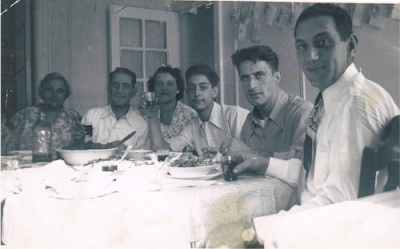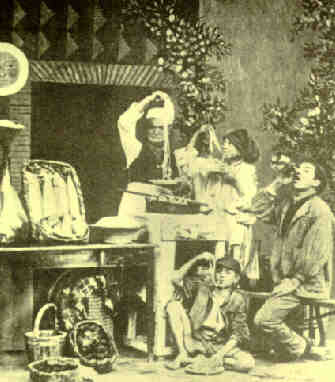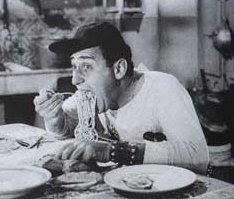There is much more to Italian food culture than many people outside Italy realize. Mastering the art of Italian cooking is not just a matter of learning recipes but rather requires coming to understand a whole approach to the preparation and eating of food. This approach can be understood, among other ways, through a series of unwritten “rules” that guide most Italians' culinary habits. (I use the term loosely, as there are exceptions to most of these 'rules.' And there is no Italian food police to arrest you if you break them.)
Here are twenty basic rules explained, some of which may surprise you:
General Rules
Rule 1: Eat in season. This ‘rule’ is valid anywhere, but is often observed only in the breach. Italians still do follow it by and large. Asparagus is for the spring, tomatoes, zucchine, peppers for the summer, mushrooms for the fall, cabbage and hearty stews in the winter, and so on. Order a risotto ai funghi porcini in a restaurant in mid-summer and you may get some strange looks. This rule, unfortunately in my opinion, does seem to be breaking down some. In the last few years while I was in Rome, out of season fruits and vegetables, imported from warmer climes, began appearing in the supermarkets (never the open air markets) but they were very expensive and, of course, not very tasty. Frozen vegetables are also beginning to catch on, which also allows for out of season cooking but at the expense of freshness.
Rule 2: Eat locally. Italians were locavores long before it became fashionable (or the word even existed). For most of history this was a matter of necessity for all but a privileged few, but this way of eating continues now that prosperity is widespread. Even the short train trip from Rome to Florence can be like a visit to a foreign land in culinary terms. On the other hand, these days, as elsewhere, regional differences are beginning to blur. A number of local specialities have become national dishes and are eaten most everywhere (eg, pizza). But they are still best experienced in their native territory. If you’re in Italy as a tourist, there’s no point in ordering pizza in Milan or a risotto in Naples. Try to do a little research before visiting a town and try the local specialties.
Rule 3: Look for a harmonious combination of ingredients and avoid clashing combinations. Generally speaking, Italians feel that fish and cheese do not mix. (Never put grated cheese on pasta alle vongole!) But there are various exceptions to this rule. For example, mozzarella and anchovies are often paired. It is also not unheard of to combine fish with cream and with some milder cheeses, so perhaps more accurate to say that fish and aged cheese do not mix. Mushrooms and cheese are another dubious combination, but here, too, there are exceptions like mushroom salad with parmesan shavings.
The structure of an Italian meal
Rule 4: There is no such thing as a ‘main course’ in a proper Italian meal, but rather a series of courses of varying number, depending on the occasion, but usually including a primo (first course of pasta, soup, polenta, rice, etc.) and a secondo (meat, fish, vegetable), often served with a contorno (vegetable side dish). Fresh fruit usually serves as dessert. Or more formal occasions, an antipasto comes before the primo, and a proper dessert may close the meal. In the old days, formal dinners could also have an ‘intermezzo’ between the primo and secondo. It is possible to double or even triple-up primi and/or secondi at elaborate dinners as well, in which case the portions are reduced accordingly. But having two pasta dishes, or a soup followed by the pasta, is a common mistake made by non-Italians. The notable, and increasingly common, exception to this rule is the piatto unico, or ‘single dish’, that serves as both primo and secondo.
Rule 5: The courses of a meal should provide variety without clashing. A delicate egg pasta would not generally be followed, for example, by a spicy dish like fettine di manzo alla pizzaiola. And it is preferable not to repeat key ingredients from course to course—a pasta with tomato sauce, for example, would best not be followed by a meat dish that features tomatoes. (Although it is quite common in southern Italy to follow a pasta and meat ragù with the meat that was used to make the ragù.) At the same time, a dinner that begins with seafood often continues with seafood in later courses. A rule of thumb for beginners: try to stick to dishes of a single region for the various courses; they are more likely to go well together.
Rule 6: Pasta, risotto, gnocchi and the like are not served as side dishes but, as mentioned above, as a separate course. The exception would be for piatti unici like ossobuco (braised veal shank) and risotto alla milanese, often served together. Polenta is often served with meats as a piatto unico, as in polenta e osei or polenta and sausages.
Rule 7: Salads are most often served contorni (side dishes). Certain salads, in particular composed salads like a caprese can serve as antipasti. The Italian immigrant custom of serving green or mixed salad as a separate course after the secondo and before the fruit is not generally followed in Italy.
Cooking pasta
Rule 8: Most people know by now that pasta should be eaten ‘al dente’. (See the glossary at right if you don’t know.) But it is possible to overdo this rule. Generally speaking, pasta secca, which is made with durum wheat flour, will have a much firmer consistency than pasta fresca, which is (or should be) made with soft “OO” flour. In the US (and perhaps elsewhere) however, commercially sold tortellini and other egg pastas are often made with durum wheat pasta, giving them an excessively firm consistency. These pastas should be cooked well to achieve the right consistency.
Moreover, what exactly ‘al dente’ means in practice is highly personal. Generally speaking, northern Italians will consider ‘al dente’ a relatively softer consistency, and southern Italians a relatively firmer consistency. In no case should pasta be chalky to the bite, nor should it be mushy or soggy—the pasta should provide resistance when you bite into it. Within these general limits, the issue is basically one of personal taste. In his excellent book Cuochi si diventa, renowned Milanese gastronome Allan Bay says that “ogni italiano ha il suo punto di dente, parlare di questo è del tutto inutile”, which is to say “every Italian has his or her own definition of the point when pasta is done al dente, so talking about it is useless.” Do be aware, however, that pasta will continue to cook for a while after it is drained, even more so if you mix it with its sauce over low heat, as is so many recipes call for. So drain your pasta while it is still just slightly ‘underdone’ for your taste.
Equally important, in my mind, to cooking pasta al dente, is making sure that the pasta is cooked in abundant, well-salted water. The general 'rule of thumb' is one liter of water for each 100g of pasta, which is easy to remember. (NB: 75-100g is the normal portion of pasta for one person.) But you really can never have too much water, so err on the side of more rather than less water. And don't be too shy with the salt or your pasta will turn out sciapa--insipid. The water should actually taste salty, like a soup.
Rule 9: It is important to pair the ‘right’ pasta shape with the ‘right’ sauce. It is difficult (impossible, actually) to give hard and fast rules—this is something that you get a feel for over time and with experience. But some general rules of thumb are possible. For this purpose, it is useful to group pasta shapes into three broad categories: ‘long’ pastas like spaghetti, bucatini or linguine; ‘short’ or ‘stubby’ pastas such as penne and rigatoni; and ‘soup’ or ‘spoon’ pastas such as ditalini or stellette. Long pastas tend to go well with tomato and other smooth sauces, as well as garlic and oil based sauces like clam sauce. Short pastas, especially those with a concave shape or with holes in them, tend to go well with chunky sauces, such as chiocciole con salsiccia, piselli e ricotta. Spoon or soup pasta, as the name implies, go well with soups and soup-like dishes eaten with a spoon, like pasta e piselli. Beware: the names of pasta shapes can vary across regions, like bucatini, which are called perciatelli in Naples.
Another important distinction is between pasta secca, factory-made durum wheat pasta, and pasta fresca, egg pasta made with soft “OO” flour. Generally speaking, oil based and ‘rustic’ sauces from southern Italy go with pasta secca, and delicate, cream- or butter-based sauces from the North go with pasta fresca. But there are many exceptions to the rule. Carbonara, for example, is typically made with spaghetti, but can also be made with short pasta like penne or rigatoni, or even with fettuccine.
If you are new to Italian food, it would be a good idea to stick to classic combination; on this site, recipes will indicate the specific type(s) of pasta that go with a particular sauce, together with suggestions for alternative pasta shapes where appropriate.
Rule 10: It is equally important not to over-sauce your pasta. You should 'dress' the pasta with just enough sauce to flavor it, just as you would dress a salad. In fact, the verb condire in Italian is use both for dressing a salad and for saucing pasta. The photographs that go with the recipes on this site provide an indication of how the dish should turn out.
Rule 11: Don’t assume that grated cheese goes on every pasta dish. In general, as mentioned above, cheese does not go on pasta with fish sauces. Nor does it go on ajo e ojo or other garlic-and-oil based pasta dishes. Spicy dishes call for ‘spicy’ cheese like pecorino, not parmigiano, or even more often, no cheese at all. On this blog, the recipe will specify whether the dish calls for grated cheese. If nothing is said, then the dish does not call for grated cheese.
Rule 12: Pasta salads are almost always made with pasta secca, although there are some egg pastas such as garganelli that lend themselves to pasta salad. There is no such thing in real Italian cooking, for example, as a ‘tortellini salad’. More popular in Italy than pasta salads are dishes where hot pastas are mixed with a cold ‘sauce’ such as raw tomatoes, garlic, fresh basil and olive oil. Pasta salads are rarely (if ever) made with mayonnaise.
Eating your greens
Rule 13: Except in the fanciest of restaurants, vegetables are not there for garnish. They are meant to be eaten.
Rule 14: Salad dressing is made from oil and vinegar (or lemon). Do not expect to find ‘blue cheese’ or ranch dressing—or any other kind of bottled dressing, for that matter. Dressings are not prepared separately and poured on the salad, but oil, vinegar and salt are added sequentially and each mixed with the greens. An exception is puntarelle, a kind of wild chicory, which are dressed with a garlic and anchovy dressing, which is prepared separately.
Beverages
Rule 16: Mineral water and/or wine are the beverages of choice to accompany your meals. Beer is becoming increasingly popular, especially with pizza. Avoid soda pop, milk and, as mentioned above, coffee. (NB: I’ve seen some young Italians drink Coke with their meals, especially with pizza. Ugh…) And PS: It is said to bring bad luck to toast with anything but wine.
Table Manners
Rule 17: Use a knife and fork! Even pizza is generally eaten with a knife and fork when part of a meal, although it is fine to cut up your pizza and eat the individual slices with your hand. Some exceptions: pizza ‘a taglio’, a single slice of pizza sold at stands, tramezzini and panini, ice cream cones, scottadito, all of which are eaten with the hands, but even some of these are eaten with a napkin wrapped around the food to avoid direct contact.
Rule 18: Do not cut your spaghetti. Twirl it on your fork. And unless you are 6 years old or younger, do not use a spoon.
Rule 19: Do not eat bread with pasta. But you can (if eating with friends informally) fare la scarpetta, i.e. sop up the extra sauce that’s left after you’re finished the pasta (or another dish with a sauce). Unless you are at home among friends, use a fork. Except in some regions of northern Italy, you will not find bread served with butter. If you ask for it, you may get some odd looks. Nor is dipping bread in olive oil as you wait for a meal an Italian custom. (It’s not clear where that got started.) There does exist an antipasto called pinzimonio consisting of cut fresh vegetables that you dip into olive oil seasoned with salt and pepper.
Rule 20: When eating at someone’s home, if you leave food on your plate, your host may wonder if you didn’t like it. Your host may ask you if you liked the dish, just to make sure nothing was wrong. Of course, it is fine to explain that the food was delicious, but you are full—except, that is, if your host is your Italian mother or grandmother...
A final word of advice...
Finally, let us close not with a rule but an attitude, summarized by the expression: “a tavola non s’invecchia”, meaning “at the table you do not age”. In other words, don’t rush through your meals, don’t eat them in your car while driving or at your desk. Sit down with friends, take your time and enjoy!
PS: This post was developed in discussion with other 'foodies' on the site "Foodbuzz" and will be updated as the discussion continues. Many thanks all of them for their contributions to this subject.






